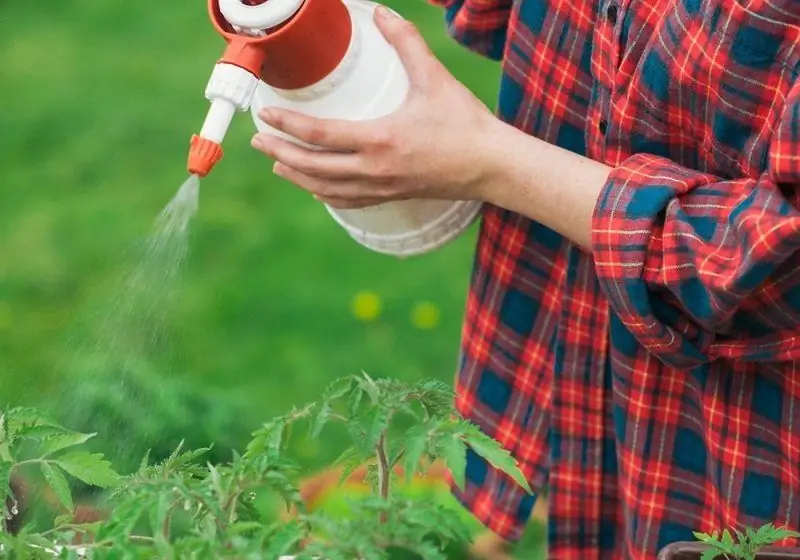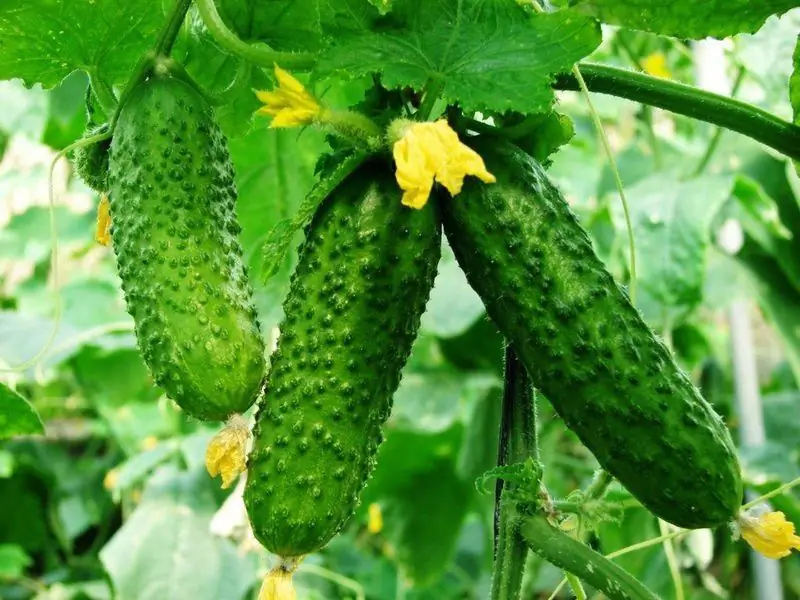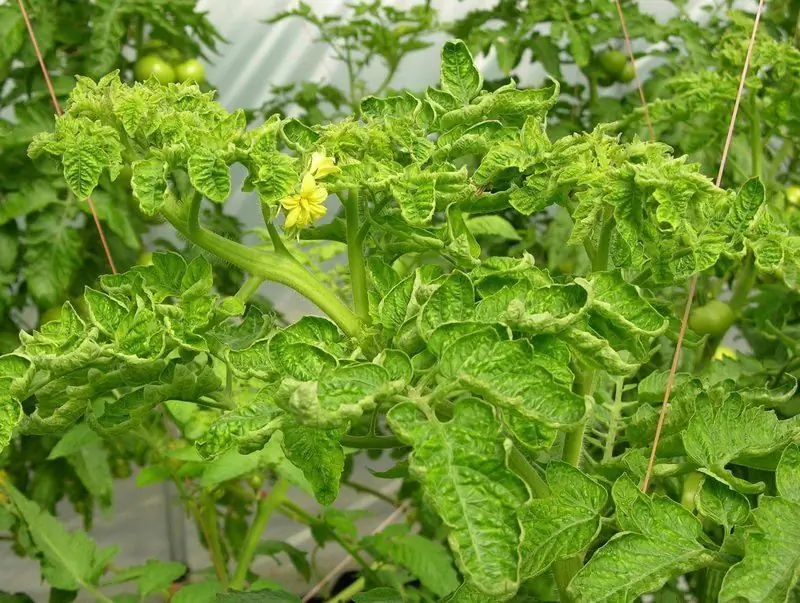
Table of contents:
- Author Bailey Albertson [email protected].
- Public 2023-12-17 12:53.
- Last modified 2025-06-01 07:32.
How to process tomatoes from late blight for prevention and treatment

When growing tomatoes, gardeners are faced with a dangerous infection - late blight. The consequences of the disease are catastrophic, therefore, if signs of the disease are detected, urgent measures are taken. Prudent summer residents do not allow infection of plants with the help of prevention.
Content
- 1 Description of the disease, what kind of "tomato plague"
-
2 Spraying tomatoes
- 2.1 Folk recipes
- 2.2 Protecting tomatoes from late blight with serum and iodine - video
- 2.3 Ready-made store preparations
- 2.4 Organic products
- 2.5 Chemical fungicides
- 2.6 Fight against late blight - video
Description of the disease, what is this "tomato plague"
Brownish rounded spots on the tops, rapidly increasing in size, signal the infection of tomatoes with late blight. Soon the leaves sag lifelessly, the infection affects the fruits, the plants die. Previously, the peak of the spread of the disease occurred in the second half of the summer against the background of high humidity. But recently a new strain of southern phytophthora has appeared, developing since June.
The disease is caused by spores of the phytophthora fungus, which settles in drops of water on the foliage, stems, fruits of nightshade crops and germinates in them. Aggressive mycelium, sucking nutritious juices, devours plants in 1-2 weeks.

At the last stage of late blight, when all the leaves have dried up, the plant can no longer be saved
Spraying tomatoes
Late blight is treated only in the early stages, when 1-3 leaves are affected. In other cases, it is possible only to suspend the development of the disease. Therefore, it is important to prevent infection by taking preventive measures:
- disinfect and deacidify the soil in the garden or greenhouse;
- plant bushes in the sun;
- water only at the root;
- cut off the lower leaves and stepsons;
- regularly treat with protective agents against late blight;
- mulch tomatoes.
These actions will reduce the risks of infection. The main rule for spraying nightshades from fungal infections is processing the leaves on both sides.

Some gardeners "treat" tomatoes with antifungal agents from a watering can instead of a sprayer, but this is wrong, since the treatment solution completely drains off
Folk recipes
Tomatoes have been processed since early summer. Folk remedies do not treat late blight and are prophylactic. Warm solutions are used, prepared independently from food products, plants, pharmaceutical preparations.
- In the open field, tomatoes are sprayed in the morning once every 5-7 days and after each rainfall.
- In the greenhouse, this is done less often - once every 7-14 days, since there the drug is not washed off by rain.
Pharmacy antiseptics help to resist late blight. To prepare a working solution in 10 liters of water, dilute:
- 2 ml of iodine;
- or 3 ml of greens.

Iodine not only protects against infections, but also accelerates the growth and maturation of tomatoes
Ordinary garlic prevents the development of fungal diseases. Take 200 g of chives, chop with a knife or in a meat grinder and pour in a liter of warm water. After a day, filter and bring the volume to 10 liters.

Garlic protects against late blight thanks to the substances that make up it: iodine, sulfur, phytoncides
Phytophthora and other fungi prefer an acidic environment, and do not grow in an alkaline one. To prevent spores from growing on the leaves, an ash broth is sprayed over the tomatoes. A glass of wood ash is poured with a liter of hot water and boiled for 15 minutes. After straining, the liquid is diluted in 9 liters of water. It is also useful to powder the soil under the tomato bushes with ash.

Wood ash, in addition to protecting against late blight, will feed tomatoes with potassium and microelements
An alkaline medium will create a soda solution on the leaves: 1.5 tbsp. l. for 5 liters of water. It has been noticed that the use of sodium carbonate improves the taste of the fruit.

Baking soda protects against late blight and powdery mildew in the garden
The straw is home to hay bacillus bacteria - antagonists of pathogenic fungi. To prepare a protective agent in a bucket of water, dissolve 1 tbsp. l. urea and add 1 kg of hay or rotten straw. After 5 days, the infusion is filtered.

For the preparation of hay infusion, you can take the dried cut grass left over after mowing the lawn
Instead of a hay stick, the tops are also populated with yeast fungi, since late blight does not tolerate such a neighborhood. In three liters of water preheated to 38 to C, 5 are dissolved art. l. sugar and a ten-gram bag of dry yeast. The liquid is left warm for 5 hours and stirred periodically. Then the volume is brought to 10 liters and the tomatoes are sprayed. It is also permissible to feed the plants under the root with the prepared solution to stimulate growth: 1 liter per adult bush.

Sometimes old jam is added to yeast water instead of sugar.
Treatment with a decoction of horsetail postpones the onset of the epidemic. A liter of water is poured into 100 g of dry or 150 g of fresh grass and cooked for 40 minutes. After straining the broth, the volume is brought to 5 liters.

If horsetail does not grow nearby, buy it at the pharmacy
Finally, the most popular remedy is milk solution. In 9 liters of water, 1 liter of natural is diluted: milk, kefir or whey. The efficacy of such liquids is based on the theory that phytophthora spores are difficult to germinate on leaves covered with a film of lactic bacteria. To enhance the effect, 15-20 drops of iodine are dissolved in water before adding dairy products. According to reviews, such a solution helps in the prevention of infections. In the greenhouse, open vials with iodine are additionally suspended.

Whey or milk with iodine, like other folk remedies, protect against fungal diseases only with regular treatments
We protect tomatoes from late blight with serum and iodine - video
Ready-made store preparations
Purchased remedies for late blight are easier to prepare. Some of them contain beneficial bacteria and are used exclusively for disease prevention. Others contain anti-fungal chemicals called fungicides that protect against late blight infection or stop it.

Protect hands with gloves and face mask when handling fungicides
Organic remedies
The aforementioned hay bacillus, or Bacillus subtilis, is also noticed by manufacturers of plant protection products. Spores of the bacteria are contained in the famous Fitosporin-M, which is available in the form of a paste or powder. The biological product works better in greenhouse conditions, since it is not washed off the leaves by rain. Not only sprinkling is practiced, but also watering the soil under the bushes. To preserve the population of beneficial bacteria, a constant soil moisture is maintained.
The drug is diluted according to the instructions in settled warm water. Plants and the surrounding land are cultivated in the open field every 7-10 days and after rain throughout the summer. In the greenhouse, tomatoes are sprayed once every 2 weeks. In gardening stores, there are effective analogues of Fitosporin: Gamair, Fitodoctor.

When preparing Fitosporin, the stock solution is first diluted in a small container.
Chemical fungicides
It is tempting to do with milk and bacteria, but experienced gardeners and farmers do not risk it, but turn to inorganic chemicals, since late blight sometimes destroys up to 100% of the crop.
When choosing a product, take into account that systemic chemicals protect the plant from the inside, contact chemicals work on the surface of leaves and fruits. Most often, the latter are made on the basis of copper and are used when the tomatoes are already ripe. The waiting period is two weeks. When late blight is detected, diseased leaves are cut off and destroyed, ripening fruits are removed for storage, and the bushes are sprayed with a solution of copper sulfate or Hom. The processed fruits are simply washed under running water before use.

Copper does not penetrate into tomatoes, so washing them is enough to eat
The best protective and therapeutic effect is provided by chemicals containing, in addition to copper, other fungicides. For example, the drug Ordan (Kurzat) contains copper oxychloride and cymoxanil. In tandem, the listed components destroy the phytophthora mycelium.

Ordan is used not only on tomatoes, but also on other nightshades: potatoes, peppers, eggplants.
Tomatoes are sprinkled with systemic and contact-systemic means when at least 20-30 days remain before ripening. The procedure is performed in the early morning or evening. According to the assurances of manufacturers, chemicals decompose into safe substances within 3-4 weeks. Effective fungicides include:
- Akromat MC;
- Quadris;
- Consento;
- Profit or Ridomil Gold;
- Rajok;
- Revus;
- Thanos.

Consento is a new fungicide with low human toxicity
Tomatoes are re-processed in 10-14 days, with precipitation in 8-9 days. It is permissible to spray each preparation over tomatoes 3-4 times per summer. It is important to alternate fungicides with different active ingredients so that fungi do not develop resistance.
Often we ourselves help the binge of fungal infections by overfeeding tomatoes with nitrogen fertilizers. Once, when planting bushes, I added a complex fertilizer for tomatoes to the hole, and after a while I fed it with manure infusion. The tomatoes healed, the leaves became brittle and friable, phytophthora spores easily germinated in the tissues and the plants got sick at the end of June. Conclusion: tomatoes do not tolerate an excess of nitrogen and will get sick ahead of time. The taste of the fruit will also deteriorate.
Convincing a novice gardener of the ineffectiveness of folk remedies and Fitosporin in the treatment of late blight is as difficult as proving to a child that Santa Claus does not exist. I was the same, hoped for a miracle and lost my harvest. Here you need to understand one thing: if the phytophthora mycelium has already sprouted inside the leaves, then the milky film or spores of the hay stick on the surface no longer bring any benefit. It will be possible to suspend late blight only with inorganic agents that will destroy the fungus. In mid-June, I try to treat tomatoes with a systemic fungicide. Effective protection - from the inside, proven by years of practice.
Fight against late blight - video
Folk remedies and biological products are used to prevent late blight of tomatoes. Depending on the weather, treatments are repeated every 7-10 days. But a more sure way of protection is to sprinkle tomatoes with a systemic fungicide that acts inside the plants 20-30 days before ripening. If tomatoes become infected during ripening, the affected foliage is cut off, ripening fruits are harvested, and the bushes are treated with a contact preparation with a short waiting period.
Recommended:
How To Pinch Tomatoes Correctly In A Greenhouse And Open Ground (video, Photo, Diagram), Which Varieties Do Not Require Pinning

Practical advice for pinching tomatoes of different varieties. Pinion schemes for the formation of a bush in one, two and three stems
How To Tie Up Cucumbers In The Greenhouse And Open Field

What are the benefits of a garter of cucumbers, what problems it relieves. Universal rules. Habitual and non-standard ways of tying + photos, videos
Salt From Late Blight On Tomatoes: How To Properly Process Tomatoes

What is the mechanism of protection of tomatoes from late blight with the help of table salt. How often should plants be treated, what should be the concentration of the solution
The Tops Of Tomatoes In The Greenhouse And Open Ground Are Curling Up: What To Do

Why do tomatoes have curly tops (in a greenhouse or open ground): care errors, diseases, pests. Ways to solve these problems
Why Do Tomatoes Crack And Burst (on A Bush In An Open Field And In A Greenhouse), What To Do

Why do tomatoes crack and burst (on a bush in an open field and in a greenhouse). How to deal with the problem
